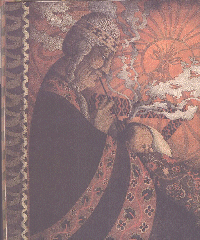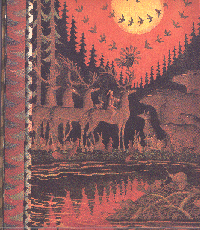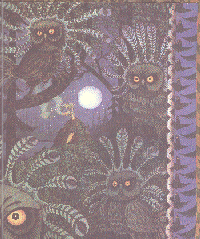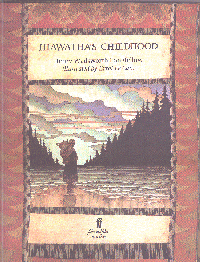



Hiawatha's Childhood
Illustrated by Errol Le Cain
first published 1984.

Bettina Hurlimann, writing in 'Three Centuries Of Children's Books In Europe', poses a question:
Up and down the country today, it is still a fairly frequent occurrence to see children playing in feathered headdresses, waving their plastic tomahawks or their unsmokeable pipes of peace..... . Why does almost every 12 year old child today know almost as much about the Sioux Indians as be does about the original inbabitants of our own country?..."
In 1850, the answer would have been, "From reading James Fenemore Cooper!"
Cooper's novels, though not corresponding to historical truth, fed the
voracious appetites of readers for whom the Romantic Movement in European and American Literature had already idealized the frontiersman and ennoblized bis Indian Brother. The Publication, in 1855, of Longfellow's 'Song Of Hiawatha', based on the traditions of Indians living on the shores of the Great Lakes, was timely.
In this long poem, the first work of his retirement from University Life, Longfellow created an Indian counterpart to the European Hero-sagas that had first fascinated him during his earlier study tours of the Continent. Heavily influenced by German and Scandinavian poets, he modelled his poem on the Finnish collection, 'Kalevala', and would not have envisaged that his epic would become one of those pieces of adult literature that children take, from time to time, as their own.

Children who are profoundly sympathetic to the affairs of Nature and quite
averse to the affairs of economists, must necessarily give their hearts to the Indians and adopt them completely into their literature.."

`Hiawatha's Childhood', the section of the saga deemed most appropriate for children, has appeared in countless anthologies and readers. John Drinkwater once described Longfellow's ability as an 'awakener of poetry in the young' in a selection of mixed metaphors Longfellow would never have countenanced:

"He has been the genial and inspiring doorkeeper of the temple. His easy and satisfying rhythm, his rich yet simple suggestion of things venerable and picturesque and a certain unction in all he wrote, combine to make his works the very tuckshop of poetry for young readers..."

Now, to that smorgasbord, is added another 'Hiawatha's Childhood', this version a Greenaway Medal winner, (1984). Published by Faber and Faber, it is presented in picture-story book form, illustrated by Errol Le Cain, a Hong Kong expatriot resident in Britain but gaining international accreditation. Not for Le Cain the lightweight illustrations prevalent in Reading Scheme Primers; not for Faber the 'translation' for kiddies, the talking down or compromise or structured vocabulary. Instead, Longfellow's original, unadulterated, alliterative verses are presented in sizeable slabs of 3mm. print, attractively yet firmly bordered off from the pictures so that young readers can concentrate on the one or the other. The artwork would appear to have borrowed from Middle Age manuscript illumination, if that artform can be imagined executed in 'Red Indian' style. Pages are richly edged and embellished in intricate earth-coloured motifs ever suggestive of the underlying, ancient culture.

This Hiawatha is not your average 'Noble Savage'. Presented first as a swaddled, diminutive infant dwarfed by the magnitude of fir-forest and mountain, he grows, both in stature and wisdom as the book progresses, conquering his own Wild Things, until, at the end he rides the reindeer under the satisfied, benevolent smile of Nokomis, she as weatherbeaten as an ancient rock, as dignified and stately as tbe princess of an ancient race.

Nights are long and deeply blue by the shores of Gitchee Gumee, and bright with fireflies, stars, and the mysterious eyes of owls. The wigwam is ochre-warm against spectacular grey-white winters, but summers are vibrant green-gold, birds and animals abound, and the rainbow spans a double page to end at the feet of Nokomis and Hiawatha.
There is a wealth of detail in the pictures. Everything mentioned in each verse can be found in the corresponding illustration, but this is not an example of the 'picture aiding prediction' approach to early reading. Instead, this is a superb example of illustrations complementing and supplementing an already self-sufficient text, a text proven by time, and not to be subjected to linguistic analysis here.

Too often, children's books are 'bandwagon' literature, contrived to follow a trend or serve a cause. Such may have been the case with 'The Song Of Hiawatha' in 1855. Since then allegiances, fashions and ways have changed. Wars have been won and lost. Man has walked on the Moon. We have found a new way of making babies. The technology of communication, unknown to Longfellow, brings boycotts and carbombs to children over dinner. Yet this book has no rockets, no lasers, no popups or see-throughs or choose-your-own-endings. Nor has it bunnies in pinafores. It is simply a book full of beautiful words and inspired pictures which says something eternal about the time we call childhood, for like all good literature it has a moral, and a theme.
 >
>In 'Children and Fiction', Wallace Hildick, discussing books designed to be read aloud, makes the following points:

"One must take into account the amateur status of most readers-aloud-to-children the fact that, teacher, parent, or friend, such a reader will not generally have the skill of a trained actor. Therefore a style that sings itself is desirable... a style that as far as possible imposes its own rhythms and emphases and pauses and inflections on the reader..."

After 130 years, these verses still sing themselves in harmony, and children will want to hear that song again and again. This is a book that belongs in every school library, in every teacher's private collection, and in every home where children and books are brought joyfully together. A tuckshop? This is a banquet spread before us.


DRINKWATER, John, ed. The Outline Of Literature.London, Newnes, (1950).
HURLIMANN, Bettina, (trans. Brian Alderson): Three Centuries Of Children's Books In Europe. London, Oxford UNiversity Press, (1967).
HILDICK, Wallace: Children And Fiction. London, Evans Bras., Revised ed., (1974).

Want To Check Out Price And Availability of the Paperback edition?
Want To Check Out Price And Availability of the Hardback edition?
 |


 Reactions, Comments and suggestions to: robink@mail.austasia.net
Reactions, Comments and suggestions to: robink@mail.austasia.net